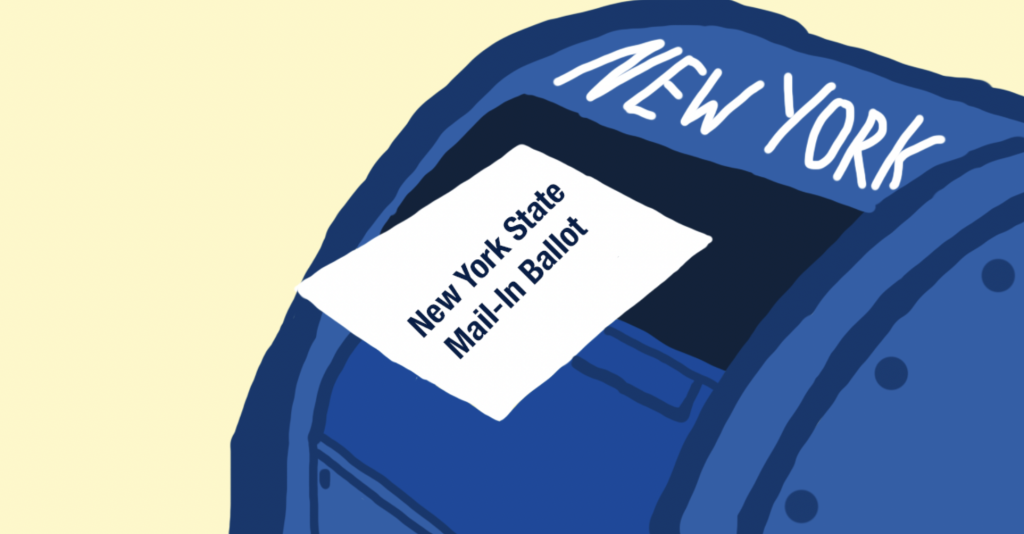The New York State Court of Appeals upheld a law allowing all registered voters to cast ballots by mail last month.
The 6-1 decision, authored by Chief Judge Rowan Wilson, involved a challenge to the Early Mail Voter Act, a law signed last September by Gov. Kathy Hochul that allows voters to request an early mail ballot. Two years before, voters failed to pass a constitutional amendment enabling universal absentee voting. A coalition of Republican-aligned organizations and individuals, led by Rep. Elise Stefanik of New York’s 21st Congressional District, filed a lawsuit against Hochul, the Board of Elections and New York state, among others, on the same day that the legislation was signed into law.
The lawsuit argued the act violated the New York Constitution, saying the legislature previously assumed it mandated in-person voting except in cases where an individual was ill, physically disabled or was set to be absent from their resident county on Election Day. The state Supreme Court in Albany dismissed the lawsuit, upholding the Early Mail Voter Act as constitutional, which the Appellate Division affirmed. The plaintiffs then appealed to the Court of Appeals, the highest court in the state.
The Court of Appeals concluded that no part of the state constitution clearly requires in-person voting. It reviewed the constitution’s evolution from its initial 1777 adoption and focused on a specific provision, added in 1821, mandating voting “in the election district” where one resides and “not elsewhere.” The Election District Provision was repealed in 1966 and the legislature enacted laws in recent decades allowing absentee voting for groups like election workers and first responders. The court acknowledged that 2021 voters rejected an amendment authorizing universal absentee voting but emphasized that their job was to determine the requirements set forth by the law.
“Upholding the Act in these circumstances may be seen by some as disregarding the will of those who voted in 2021,” Wilson wrote. “But our role is to determine what our Constitution requires, even when the resulting analysis leads to a conclusion that appears, or is, unpopular. Had there been a clear, unequivocal, and persistent understanding by our coordinate branches that the Constitution required in-person voting, this would be a more difficult case. However, the lack of textual support for an in-person voting requirement and the equivocal nature of the constitutional history regarding such a requirement do not allow us to overcome the very strong presumption of constitutionality we must afford to the Act.”
The decision will allow millions of registered voters to cast ballots by mail ahead of the November election. More than 1.5 million New Yorkers cast absentee votes in 2020 when former Gov. Andrew Cuomo signed legislation permitting voters concerned about contracting illnesses like COVID-19 to request absentee ballots. Hochul applauded the court’s ruling as protecting voter access for all New Yorkers.
“Generations of Americans fought to secure and protect the right to vote, and we have a responsibility to continue removing the barriers that persist today that prevent far too many people from exercising that right,” Hochul said in a statement last month. “Today’s ruling is a significant victory for democracy and another loss for those who seek to disenfranchise New Yorkers and undermine access to the ballot.”
Judge Michael Garcia dissented from the decision and argued that the State Constitution implicitly mandated in-person voting as a default rule. Garcia believed the constitution’s explicit “grant of authority” for the legislature to permit absentee voting in certain circumstances implied that the legislature had a “lack of authority” to expand access further. Stefanik criticized the decision following its release and called the state court system “disgraceful” in an August statement.
“Today’s ruling has essentially declared that for over 150 years, New York’s elected officials, voters, and judges misunderstood their own state’s Constitution, and that in-person voting was never required outside the current legal absentee process,” Stefanik said.
College students who register at their home address typically rely on mail or absentee voting to cast their ballots. For the 2024 New York general election, all early mail or absentee ballot applications sent by mail or through the online request portal must be received at the county board of elections by Oct. 26. Ryan Gaire, the president of Binghamton University’s College Democrats and a junior majoring in political science, said he believes the court’s decision will help safeguard voting rights from political attack.
“The right to vote has been tirelessly fought for by generations, and the court’s ruling to protect the voting rights of New Yorkers by allowing mail-in ballots will allow millions of more citizens to exercise that right,” Gaire wrote. “Efforts by Republicans to fearmonger about nonexistent voter fraud are anti-democratic and we must stand against them in order to protect one of the most sacred rights of our country.”
The College Republicans declined to comment on the court’s decision.
Students on campus with election-related concerns can visit the Center for Civic Engagement, located in University Union 137, which connects students with community engagement programs and voting resources. The center coordinates a nonpartisan program encouraging student voting and will host short presentations about the registration process if requested by a professor during classes.
“Many students already vote absentee if they are registered to vote in their hometown, and the new law gives more students the option to vote through the mail if they prefer,” wrote Alison Twang, the center’s director. “Whether students are voting by mail, during early voting or on Election Day, we encourage all students to make their voting plan ahead of time. Students can find more information and resources on the Center for Civic Engagement’s webpage.”



